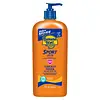What's inside
What's inside
 Key Ingredients
Key Ingredients

 Benefits
Benefits

 Concerns
Concerns

 Ingredients Side-by-side
Ingredients Side-by-side

Butyl Methoxydibenzoylmethane 2.7%
UV AbsorberHomosalate 9%
Skin ConditioningEthylhexyl Salicylate 4.5%
UV AbsorberOctocrylene 6.5%
UV AbsorberWater
Skin ConditioningGlyceryl Stearate
EmollientPEG-100 Stearate
Cetyl Alcohol
EmollientCetyl Dimethicone
EmollientPropylene Glycol
HumectantPhenoxyethanol
PreservativeCaprylyl Glycol
EmollientVp/Eicosene Copolymer
Acrylates/C12-22 Alkyl Methacrylate Copolymer
Behenyl Alcohol
EmollientSodium Polyacrylate
AbsorbentChlorphenesin
AntimicrobialXanthan Gum
EmulsifyingDisodium EDTA
Parfum
MaskingTocopheryl Acetate
AntioxidantAloe Barbadensis Leaf Juice
Skin ConditioningButyl Methoxydibenzoylmethane 2.7%, Homosalate 9%, Ethylhexyl Salicylate 4.5%, Octocrylene 6.5%, Water, Glyceryl Stearate, PEG-100 Stearate, Cetyl Alcohol, Cetyl Dimethicone, Propylene Glycol, Phenoxyethanol, Caprylyl Glycol, Vp/Eicosene Copolymer, Acrylates/C12-22 Alkyl Methacrylate Copolymer, Behenyl Alcohol, Sodium Polyacrylate, Chlorphenesin, Xanthan Gum, Disodium EDTA, Parfum, Tocopheryl Acetate, Aloe Barbadensis Leaf Juice
Aluminum Starch Octenylsuccinate
AbsorbentStyrene/Acrylates Copolymer
Glycerin
HumectantPolyester-27
Silica
AbrasivePhenoxyethanol
PreservativeIsododecane
EmollientArachidyl Alcohol
EmollientBeeswax
Emulsion StabilisingEthylhexylglycerin
Skin ConditioningNeopentyl Glycol Diheptanoate
EmollientAcrylates/C10-30 Alkyl Acrylate Crosspolymer
Emulsion StabilisingBehenyl Alcohol
EmollientTocopherol
AntioxidantArachidyl Glucoside
EmulsifyingGlyceryl Stearate
EmollientPEG-100 Stearate
Potassium Hydroxide
BufferingDisodium EDTA
Sodium Ascorbyl Phosphate
AntioxidantParfum
MaskingAluminum Starch Octenylsuccinate, Styrene/Acrylates Copolymer, Glycerin, Polyester-27, Silica, Phenoxyethanol, Isododecane, Arachidyl Alcohol, Beeswax, Ethylhexylglycerin, Neopentyl Glycol Diheptanoate, Acrylates/C10-30 Alkyl Acrylate Crosspolymer, Behenyl Alcohol, Tocopherol, Arachidyl Glucoside, Glyceryl Stearate, PEG-100 Stearate, Potassium Hydroxide, Disodium EDTA, Sodium Ascorbyl Phosphate, Parfum
Ingredients Explained
These ingredients are found in both products.
Ingredients higher up in an ingredient list are typically present in a larger amount.
Behenyl Alcohol is a type of fatty alcohol (these are different from the drying, solvent alcohols).
Fatty Alcohols have hydrating properties and are most often used as an emollient or to thicken a product. They are usually derived from natural fats and oils; behenyl alcohol is derived from the fats of vegetable oils.
Emollients help keep your skin soft and hydrated by creating a film that traps moisture in.
In 2000, Behenyl Alcohol was approved by the US as medicine to reduce the duration of cold sores.
Learn more about Behenyl AlcoholDisodium EDTA plays a role in making products more stable by aiding other preservatives.
It is a chelating agent, meaning it neutralizes metal ions that may be found in a product.
Disodium EDTA is a salt of edetic acid and is found to be safe in cosmetic ingredients.
Learn more about Disodium EDTAGlyceryl Stearate is a mix of glycerin and stearic acid.
It is used to stabilize the mixing of water and oil ingredients. By preventing these ingredients from separating, it can help elongate shelf life. It can also help thicken the product's texture.
As an emollient, it helps soften skin and supports barrier-replenishing ingredients.
In cosmetics, Glyceryl Stearate is often made from vegetable oils or synthetically produced.
This ingredient may not be fungal-acne safe
Fun fact: The human body also creates Glyceryl Stearate naturally.
Learn more about Glyceryl StearateParfum is a catch-all term for an ingredient or more that is used to give a scent to products.
Also called "fragrance", this ingredient can be a blend of hundreds of chemicals or plant oils. This means every product with "fragrance" or "parfum" in the ingredients list is a different mixture.
For instance, Habanolide is a proprietary trade name for a specific aroma chemical. When used as a fragrance ingredient in cosmetics, most aroma chemicals fall under the broad labeling category of “FRAGRANCE” or “PARFUM” according to EU and US regulations.
The term 'parfum' or 'fragrance' is not regulated in many countries. In many cases, it is up to the brand to define this term.
For instance, many brands choose to label themselves as "fragrance-free" because they are not using synthetic fragrances. However, their products may still contain ingredients such as essential oils that are considered a fragrance by INCI standards.
One example is Calendula flower extract. Calendula is an essential oil that still imparts a scent or 'fragrance'.
Depending on the blend, the ingredients in the mixture can cause allergies and sensitivities on the skin. Some ingredients that are known EU allergens include linalool and citronellol.
Parfum can also be used to mask or cover an unpleasant scent.
The bottom line is: not all fragrances/parfum/ingredients are created equally. If you are worried about fragrances, we recommend taking a closer look at an ingredient. And of course, we always recommend speaking with a professional.
Learn more about ParfumPeg-100 Stearate is an emollient and emulsifier. As an emollient, it helps keep skin soft by trapping moisture in. On the other hand, emulsifiers help prevent oil and water from separating in a product.
PEGS are a hydrophilic polyether compound . There are 100 ethylene oxide monomers in Peg-100 Stearate. Peg-100 Stearate is polyethylene glycol ester of stearic acid.
Phenoxyethanol is a preservative that has germicide, antimicrobial, and aromatic properties. Studies show that phenoxyethanol can prevent microbial growth. By itself, it has a scent that is similar to that of a rose.
It's often used in formulations along with Caprylyl Glycol to preserve the shelf life of products.